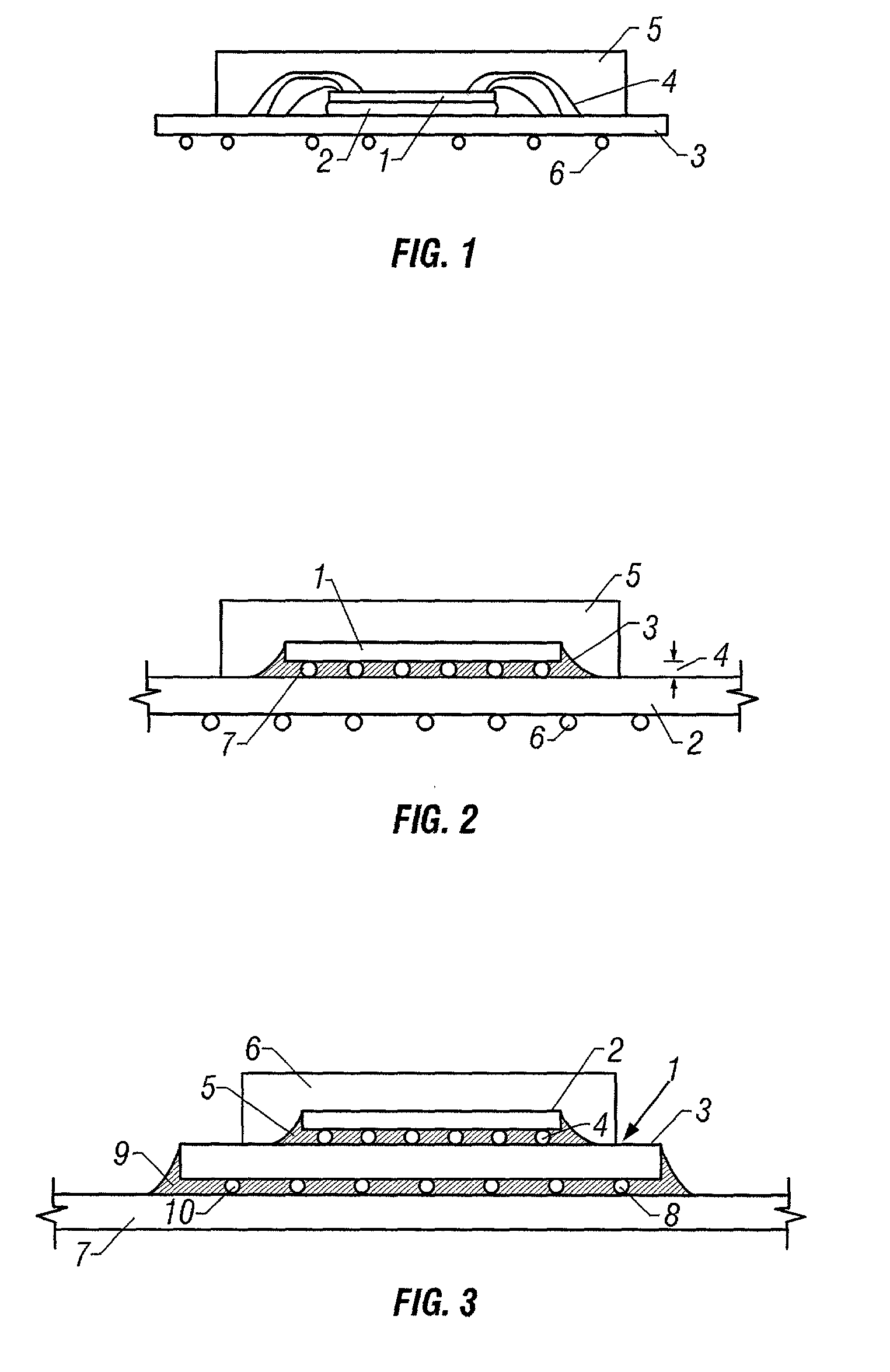Attachment of surface mount devices to printed circuit boards using a thermoplastic adhesive
a technology of thermoplastic adhesive and printed circuit board, which is applied in the direction of dielectric characteristics, sustainable manufacturing/processing, and final product manufacturing, etc., can solve the problems of chip package/pcb solder joint failure, chip package/pcb solder joint adhesion becoming more problematic, and reducing the size of each solder ball and join
- Summary
- Abstract
- Description
- Claims
- Application Information
AI Technical Summary
Benefits of technology
Problems solved by technology
Method used
Image
Examples
working examples
[0192] Films of test adhesives were prepared by placing about 1 gram of adhesive pellets on a TEFLON.TM. plate resting on top of an aluminum plate preheated in an oven to a temperature of about 200.degree. C. The pellets were allowed to heat for about 1 minute, after which a second TEFLON.TM. plate was laid on top of the molten pellets, followed by an aluminum plate weighted with a 5 lb copper bar. The assembly was allowed to heat for 10-15 minutes to about 200.degree. C., removed from the oven, clamped into a vise, and squeezed to form a 7 mil thick film. For thicker films in the range of 10-15 mils, 2 grams of the adhesive pellets were placed on the TEFLON.TM. plates in the oven, and the assembly was pressed with appropriately sized shims. From the cooled sheets, the adhesive strips or squares were cut to size.
[0193] FPE 1 is an acid functionalized polyethylene polymer functionalized with 10.5 wt % methacrylic acid having a melt index of 35.
[0194] FPE 2 is an acid functionalized p...
example 1
[0199] Thin strips measuring from 0.010" to 0.015" by 1 / 4" long were cut from the FPE 2 and the FPE 3 sheets. The FPE 2 strips were laid along the two parallel edges of a 1 / 4".times.1 / 4" glass slide 0.025" thick, and also along two parallel edges on a BGA. With the polyolefin side up, the polyolefins were bonded to the glass slides and the BGA by heating to the first stage of a Thermal Cycle. The Thermal Cycle apparatus used was a 1 / 4" TEFLON.TM. board mounted on a lift under a Dayton IR lamp equipped with 900 watt lamps. Using temperature probe thermal waxes, the distance to the heat lamp to achieve a temperature of 180.degree. C. was determined, and the time to reach 180.degree. C. was determined to be 255 seconds. Once the test sample was exposed to the heat lamp for 255 seconds, the test sample was heated in a second stage by elevating the lift to a distance from the lamp predetermined to reach 260.degree. C. within 45 seconds.
[0200] To bond the FPE 2 to the glass slide and the ...
example 2
[0204] FPE 2 adhesive was cut into 1 / 4" strips having a thickness of about 0.024", laid up along two parallel edges on a glass test slide measuring 1 / 4".times.1 / 4".times.0.040", and heat bonded to the slide by subjecting the slide, adhesive side up, to a first stage in a Thermal Cycle (ambient to 180.degree. C. over 255 seconds.). Once cooled, the glass slide was inverted, and mounted on top of a glass spacer sitting on the chip side of a printed circuit board wiped clean with acetone. The glass spacer was thick enough to provide a gap between the adhesive and the printed circuit board. The assembly was Thermally Cycled through both stages. Visual inspection revealed that the adhesive had sagged and flowed sufficiently to form a joint with the printed circuit board.
[0205] In the Mandrel bend test, the assembly passed through all deflections down to the 0.75" mandrel.
PUM
| Property | Measurement | Unit |
|---|---|---|
| Length | aaaaa | aaaaa |
| Fraction | aaaaa | aaaaa |
| Fraction | aaaaa | aaaaa |
Abstract
Description
Claims
Application Information
 Login to View More
Login to View More - R&D
- Intellectual Property
- Life Sciences
- Materials
- Tech Scout
- Unparalleled Data Quality
- Higher Quality Content
- 60% Fewer Hallucinations
Browse by: Latest US Patents, China's latest patents, Technical Efficacy Thesaurus, Application Domain, Technology Topic, Popular Technical Reports.
© 2025 PatSnap. All rights reserved.Legal|Privacy policy|Modern Slavery Act Transparency Statement|Sitemap|About US| Contact US: help@patsnap.com



